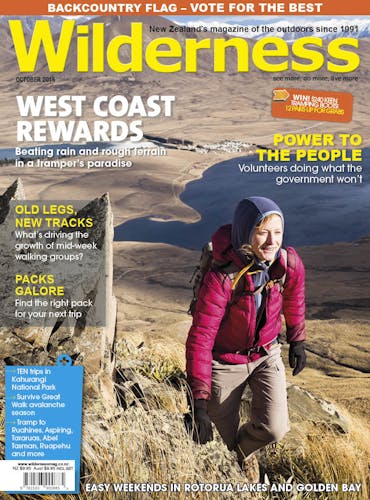Chance meetings are a wonderful thing. In this six-degrees- separated world in which we live, just walking out your front door can have you talking with an old friend, a new client or, as was the case for me recently, that one person you’ve always wanted to have a chat with. Like any outdoor person I’m slightly gear obsessed. Whether it’s the improbable robustness of an alpine tent, the pleasing curves of an expedition pack or the increasingly Buck Rogers-ish aesthetic of modern outdoor clothing, it all holds a fascination for me. So when by chance I had an opportunity to interview one of the top designers for a major international outdoor gear manufacturer I leapt at it… but immediately saw a problem: as an outdoor journalist, you don’t just chat with a gear designer.
Think about it from their point of view. When whatever you say could cost you your job, the only intelligent answers are those that have been approved by management and cleared past the public relations consultants, who would no doubt remind you of the adage: a closed mouth gathers no feet. So we agreed that, for the purposes of the exercise, I’ll just refer to them as The Architect and tell you that they work for a major international gear manufacturer. How major? Let’s just say if you’re a regular Wilderness reader I’m 99.9% certain that you own some of their stuff.
I expected them to be halfway between Sir Edmund Hillary and Andy Warhol but instead they were stylishly, though not flashily dressed, and softly spoken with a sort of Zen calmness that hinted at many deadline crises they’d seen come and go. As we sipped on flat whites in a bustling cafe it struck me that they were almost intimidatingly normal. So what do you ask that one person you’ve always wanted to chat to? As is usually the case with my interviews, my opening question was about as awkward as it gets.
“So… um… how’s work?” I stammered. According to The Architect, the world of design is changing just as fast as everything else these days. Take customer feedback. Once upon a time, finding it was a chore… but these days with everyone able to post reviews online, telling the world exactly what they think, it’s still a chore, but in a very different way. “We definitely don’t block out bad reviews. What we try to do is gather it all up at one point in time and look at it all in context [with store and product tester feedback etc].
“I think there’s a bit of tall-poppy syndrome. We’re a big company and very successful, so people love to rip into us – if you’re the biggest target you tend to get the most mud.” The upshot when you write a review online is that it will be heard by the person who first put pen to paper to bring it to life. So be honest, but be nice, eh. In many cases, they say bad reviews come down to someone (sometimes the designer) forgetting the first law of outdoor gear: “Price, performance or weight – you get two.” Although no one likes a bad review, The Architect tells me there are definitely products out there that deserve them. In their opinion, the tell-tale sign for a really bad piece of gear is just trying to be all things to all people in one product. “Usually if it’s got too much stuff hanging off it. Too many bells and whistles.
If it’s trying to do too many things.” The Architect says the best designs are “approachable”, “intuitive” and explain themselves with their own “visual language”. In other words, if you need to ask a salesperson to tell you what it does, then chances are you don’t need it. Perhaps no one does. Eventually I stumped up the courage to ask the ‘elephant in the room’ question: Is environmentalism and consumerism mutually exclusive? Outdoor retail really is a matter of selling petro-chemical- based toys to people who ostensibly love the environment. Are we all a bunch of hypocrites, or can those two strange bedfellows sleep soundly together?
“I’ve got lots of thoughts on this,” they said with a raised eyebrow. “I’m designing products to get people outside. I’m not designing a fridge or a car or a Nintendo that uses energy or fuel through its lifetime. We’re designing something to be durable and repairable and [in the case of packs] adjustable so you can hand them on to your kids or sell it to someone else and it’ll fit them, too.
“Those products are designed to get people outside enjoying the environment and hopefully encouraging them to protect the environment. To have a relationship with it and share it with their friends and family. That’s how I sleep at night.” Among gear designers, the old Eddward Abbey quote ‘It is not enough to fight for the land; it is even more important to enjoy it’, sums things up perfectly.
The thing about designers is, they’re born fixers. They tinker with something until it works. What’s really encouraging is it sounds like that mentality is being applied not just to outdoor gear, but the system that makes it. Designers who have traditionally competed against each other are beginning to collaborate, with industry working groups aimed at reducing the global warming impact of materials and production (which make up about 85% of the impact over a product’s lifetime) springing up to tackle everything from DWR toxicity in clothing to timber sustainability in snowboards.
“All these brands have realised that they can’t do it alone – it’s about volume and sharing information. So for instance, Patagonia has just developed this rubber for their wetsuits that’s way more environmentally friendly and they’re pushing it out to everyone saying ‘please use this’ because it’s better for everyone – and the environment – if the volumes are greater.”
Chatting with The Architect you get the impression that there’s nothing that can’t be fixed, improved, hacked with a pen and paper and a few sharp minds – even the whole economic system that underpins the industry. I certainly hope that’s true.







